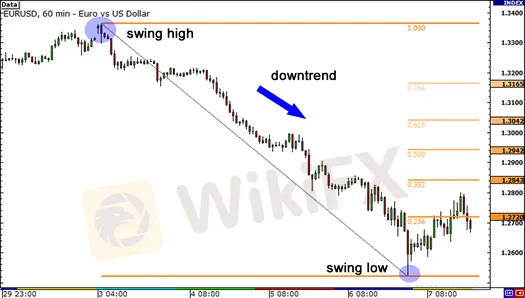简体中文
繁體中文
English
Pусский
日本語
ภาษาไทย
Tiếng Việt
Bahasa Indonesia
Español
हिन्दी
Filippiiniläinen
Français
Deutsch
Português
Türkçe
한국어
العربية
With Japanese Candlesticks, How to Use Fibonacci Retracement
Abstract:If you've been paying attention in class, you've already learned how to use the Fibonacci retracement tool in conjunction with support and resistance levels, as well as trend lines, to develop a principal but effective trading strategy.
If you've been paying attention in class, you've already learned how to use the Fibonacci retracement tool in conjunction with support and resistance levels, as well as trend lines, to develop a principal but effective trading strategy.
In this course, we'll show you how to use the Fibonacci retracement tool in conjunction with your knowledge of Japanese candlestick patterns from Grade 2.
We're seeking for comprehensive candlesticks while using the Fibonacci retracement tool using candlestick patterns.
When you can detect when purchasing or selling pressure has been expended, you can predict when price will continue to trend.
We call these “Fibonacci Candlesticks” or “Fib Sticks” around here at wikifx.com. Isn't it catchy? Let's look at an example to help clarify this.
A one-hour chart of the EUR/USD is shown below.

The pair has been on a downward trend for the past week, but it appears to have stalled for a while.
Will there be an opportunity to profit from this downturn? You're aware of what this entails. It's time to get to work using the Fibonacci retracement tool!
As you can see from the chart, we set our Swing High on March 3 at 1.3364 and our Swing Low on March 6 at 1.2523.
Because it's Friday, you've decided to relax, take an early day off, and determine when you want to enter after the charts are released over the weekend.

Whoa! By the time you opened your charts, the EUR/USD had risen significantly from its Friday closing price.
While the 50.0 percent Fib level held for a while, the pair was eventually pushed higher by buyers. You decide to wait and see if the Fib level of 61.8 percent holds.
After all, the last candle was a bullish one! Who knows, perhaps the price will continue to rise!

Will you take a look at that? A long-legged doji has developed precisely on the Fibonacci retracement level of 61.8 percent.
This is a “exhaustive candle,” as you might recall from second grade.
Has the purchasing pressure subsided? Is the Fibonacci retracement level staying as resistance?
It's conceivable. Other traders were most likely keeping an eye on that Fib level as well.
Is it time to cut your hair short? You can never be sure (which is why risk management is so crucial), but the chances of a turnaround seems pretty excellent!

You could have made some major money if you had shorted shortly after the doji developed.
The price hesitated for a few moments after the doji before continuing straight down. Take a look at how many red candles there are!
Purchasers appeared to be exhausted, which allowed sellers to reclaim control.
The price eventually dropped all the way to the Swing Low. That was about a 500-pip move! That could've been your year's best trade!
Looking for “Fib Sticks” can be quite helpful in knowing whether or not a Fibonacci retracement level will hold.
If price appears to be stalling at a Fib level, it's likely that other traders have placed orders at that level.
This would add to the evidence that there is some resistance or support at that price.
Another advantage of Fib Sticks is that they have no need for limit orders at the Fib levels.
Because we're looking at a “zone” rather than precise levels, you could be concerned about whether the support or resistance will hold.
This is when your candlestick formation knowledge will come in handy.
You might wait for a Fibonacci retracement level to form a Fib Stick right below or above it to get extra confirmation before placing an order.
If a Fib stick forms, you can simply enter a trade at market price because you now have greater evidence that the level will hold.
Disclaimer:
The views in this article only represent the author's personal views, and do not constitute investment advice on this platform. This platform does not guarantee the accuracy, completeness and timeliness of the information in the article, and will not be liable for any loss caused by the use of or reliance on the information in the article.
Read more

Forex is a game that I enjoy playing
These champions have one thing in common: they not only work their butts off, but they also enjoy what they do.

Wait patiently. Maintain your discipline
"Patience is the key to everything," American comic Arnold H. Glasgow once quipped. The chicken is gotten by hatching the egg rather than crushing it."

There isn't a Holy Grail to be found!
Ask any Wall Street quant (the highly nerdy math and physics PhDs who build complicated algorithmic trading techniques) why there isn't a "holy grail" indicator, approach, or system that generates revenues on a regular basis.

Concentrate on the Process. Profits aren't a priority
We've designed the School of WikiFX as simple and enjoyable as possible to help you learn and comprehend the fundamental tools and best practices used by forex traders all over the world, but keep in mind that a tool or strategy is only as good as the person who uses it.
WikiFX Broker
D prime
IC Markets Global
octa
FOREX.com
InteractiveBrokers
EC Markets
D prime
IC Markets Global
octa
FOREX.com
InteractiveBrokers
EC Markets
WikiFX Broker
D prime
IC Markets Global
octa
FOREX.com
InteractiveBrokers
EC Markets
D prime
IC Markets Global
octa
FOREX.com
InteractiveBrokers
EC Markets
Currency Calculator




